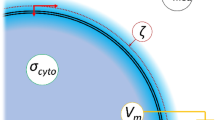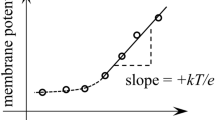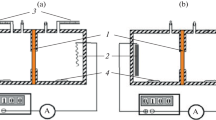Summary
The utility of the lipophilic anion thiocyanate (SCN+) as a probe for the indirect estimation of the cell membrane potential (V m ) in Ehrlich ascites tumor cells has been evaluated by comparison to direct electrophysiological measurements. SCN accumulation is consisten with first-order uptake into a single kinetically-identifiable cellular compartement, achieving steadystate distribution in 20–30 min at 22°C. The steady-state distribution ratio ([SCN−] c /[SCN−] e ) in physiological saline is 0.44±0.02. Treatment of the cells with proparanolol (0.13 mM), an activator of Ca2+ dependent K+ channels, reduces the steady-state distribution ratio to 0.19±0.02. Conversely, treatmetn with BACl2 (10 mM), an antagonist of the pathway, increases the SCN− distribution ratio to 0.62±0.01. The equilibrium potentials (V SCN ) calculated under these conditions are virtually identical to direct electrophysiological measurements of theV m made under the same conditions. The effect of varing extracellular [K+]([K+] e ) in the presence of constant [Na+] e =100 mM has also been tested. In control cells, elevation of [K+] e from 6 to 60 mM reducesV SCN from −20.6±1.0 to −13.2±1.2 mV. Again, microelectrode measurements give excellent quantitative agreement. Propranolol increases the sensitivity of the cells to varying [K+] e , so that a 10-fold elevation reducesV SCN by approximately 31 mV. BaCl2 greatly reduces this reponse: a 10-fold elevation in [K+] e yielding only a 4-mV rediction inV SCN . It is concluded that the membrane potential of Ehrlich cells can be estimated accurately from SCN− distribution measurements.
Similar content being viewed by others
References
Barty, P. H., Diamond, J. M. 1970. Junction potentials, electrode standard potentials, and other problems in interpreting electrical properties of membranes.J. Membrane Biol. 3:93–122
Barts, P. W. J. A., Hoebrichts, J. A., Klaassen, A., Borst-Pauwels, G. W. F. H. 1980. Uptake of the lipophilic cation dibenzyldimethylammonium intoSaccharomyces cerevisiae. Interaction with the thiamine transport system.Biochim. Biophys. Acta 597:125–136
Catteral, W. A., Ray, R., Morrow, C. S. (1976). Membrane potential dependent binding of scorpion toxin to action potential Na+ ionophore.Proc. Natl. Acad. Sci. USA 73:2682–2686
Dawson, W. D., Smith, T. C. 1986. Intracellular Na+, K+ and Cl− activities in Ehrlich ascites tumor cells.Biochim. Biophys. Acta 860:292–300
Dawson, W. D., Smith, T. C. 1986. Energetics of Na+-dependent amino acid co-transport in Ehrlich ascites tumor cells.Biochim. Biophys. Acta 897:5–13
Eddy, A. A. 1968. A net gain of sodium ions and a net los of K+ ion accompanying the uptake of glycine by mouse ascites tumour cells in the presence of Na+ cyanide.Biochem. J. 108:195–206
Eddy, A. A., Mulcaly, M. F., Thomson, P. J. 1967. The effects of sodium ions and potassium ions on glycine uptake by mouse ascites-tumour cells in the presence and absence of selected metabolic inhibitors.Biochem. J. 103:863–876
Geck, P., Heinz, E. 1976. Coupling in secondary transport. Effect of electrical potentials on the kinetics of ion linked cotransport.Biochim. Biophys. Acta 443:49–53
Geck, P., Pietryzk, C., Burckhardt, B. C., Pfeiffer, B., Heinz, E. 1980. Electrically silent cotransport of Na+, K+ and Cl− in Ehrlich cells.Biochim. Biophys. Acta 600:432–437
Hacking, C., Eddy, A. A. 1981. The accumulation of amino acids by mouse ascites tumor cells. Dependence on but lack of equilibrium with the sodium ion electrochemical gradient.Biochem. J. 194:415–426
Heinz, E., Geck, P., Pietryzk, C., Pfeiffer, B. 1977. Electrogenic ion pump as energy dource for active amino acid transport in Ehrlich cells.In: Biochemistry of Membrane Transport. C. Semenza and E. Carafoli, editors. pp. 236–249. Springer-Verlag. Berlin
Hemplin, H. G. 1958. Potassium and sodium movements in the Ehrlich mouse ascites tumor cells.J. Gen. Physiol. 41:565–583
Henius, G. V., Laris, P. C. 1979. The Na+ gradient hypothesis in cytoplasts derived from Ehrlich ascites tumor cells.Biochem. Biophys. Res. Commun. 91:1430–1436
Hodgkin, A. L., Katz, B. 1949. The effect of sodium ions on the electrical activity of the giant axon of the squid.J. Physiol. (London) 108:37–77
Hoffmann, E. K., Laris, P. C. 1974. Determinations of membrane potentials in human andAmphiuma red blood cells by means of a fluorescent proble.J. Physiol. (London) 239: 519–552
Hoffmann, E. K., Lambert, I. H. 1983. Amino acid transport and cell volume regulation in Ehrlich ascites tumour cells.J. Physiol. (London) 338:613–625
Hoffman, E. K., Simonsen, L. O., Sjoholm, C. 1979. Membrane potential, chloride exchange, and chloride conductance in Ehrilich mouse ascites tumor cells.J. Physiol. (London) 296:61–84
Johnstone, R. M., Laris, P. C., Eddy, A. A. 1982. The use of fluorescnet dyes to measure membrane potentials: A critique.J. Cell. Physiol. 112:298–301
Kramhoft, B., Lambert, I. H., Hoffman, E. K., Jorgensen, F. 1986. Activation of Cl-dependent K transport in Ehrlich ascites tumor cells.Am. J. Physiol. 251: C369–379
Laris, P. C., Bootman, M., Persharsingh, H. A., Johnstone, R. M. 1978. The influence of cellular amino acids and the Na+, K+ pump on the membrane potential of the Ehrlich ascites tumour cell.Biochim. Biophys. Acta 512:397–414
Laris, P. C., Pershadsingh, H. A., Johnstone, R. M. 1976. Monitoring membrane potentials in Ehrlich ascites tumour cells by means of a fluorescent dye.Biochim. Biophys. Acta 436:475–488
Lassen, U. V., Neilsen, A.-M. T., Pape, L., Simonsen, L. O. 1971. The membrane potential of Ehrlich ascites tumor cells.J. Membrane Biol. 6:269–288
Levinson, C. 1970. Steady state distribution of phosphate across the membrane of the Ehrlich ascites tumor cell.Biochim. Biophys. Acta 203:317–325
Levinson, C. 1985. Sodium-dependent ion cotransport in steady state Ehrlich ascites tumor cells.J. Membrane Biol. 87:121–130
Lichtshtein, D., Kaback, H. R., Blume, A. J. 1979. Use of a lipophilic cation for determination of membrane potential in neuroblastoma-glioma hybrid cell suspensions.Proc. Natl. Acad. Sci. USA 76:650–654
Maizels, M., Remington, M., Truscoe, R. (1958). Data for the calculation of the rate coefficients of sodium transfer by mouse ascites tumor cells.J. Physiol. (London) 140:48–60
Midgley, M., Thompson, C. L. 1985. The role of mitochondria in the uptake of methyphenylphosphonium ion bySaccharomyces cerevisiae.FEMS Microbiol. Lett. 26:311–315
Philo, R. D., Eddy, A. A. 1978. The membrane potential of mouse ascites-tumour cells studied with the fluorescent probe 3.3′-depropyloxaticarbocyanine.Biochem. J. 174:801–810
Schultz, S. G., Curran, P. F. 1970. Coupled transport of sodium and organic solutes.Physiol. Rev. 50:637–718
Schwartz, W., Passow, H. 1983. Ca2+-activated K+ channels in erythrocytes and excitable cells.Annu. Rev. Physiol. 45:359–374
Smith, T. C. 1982. The use of fluorescent dyes to measure membrane potentials: A response.J. Cell. Physiol. 112, 302–305
Smith, T. C., Mikiten, T. M., Levinson, C. (1972. The effect of multivalent cations on the membrane potential of the Ehrlich ascites tumor cell.J. Cell. Physiol. 79:117–125
Smith, T. C., Robinson, S. C. 1981a. The membrane potential of Ehrlich ascites tumor cells: An evaluation of the null point method.J. Cell. Physiol. 106:399–406
Smith, T. C., Robinson, S. C. 1981b. Variable coupling of active Na+=K+ transport in Ehrlich ascites tumor cells: Regulation by external Na+ and K+.J. Cell. Physiol. 106:407–418
Smith, T. C., Vernon, K. D. 1979. Correlation of teheffect of Ca2+ on Na+ and K+ permeability and membrane potential of Ehrlich ascites tumor cells.J. Cell. Physiol. 98:359–370
Solomon, A. K. 1949. Equations for tracer experiments.J. Clin. Inverst.28:1297–1307
Valdeolmillos, M., Garcia-Sancho, J., Herreos, B. 1986. Differential effects of tranmembrane potential on tow Na+-dependent tranport systems for neutral amino acids.Biochim. Biophys. Acta 858:181–187
Wiener, E., Dubyak, G., Scarpa, A. 1986. Na+/H+ exchange in Ehrlich ascites tumor cells. Regulation by extracellular ATP and 12-O-tetradeconylphorbol 13-acetate.J. Biol. Chem. 261:4529–4534
Author information
Authors and Affiliations
Rights and permissions
About this article
Cite this article
Smith, T.C., Robinson, S.C. Validation of the use of the lipophilic thiocyanate anion for the determination of membrane potential in Ehrlich ascites tumor cells. J. Membrain Biol. 107, 169–178 (1989). https://doi.org/10.1007/BF01871722
Received:
Revised:
Issue Date:
DOI: https://doi.org/10.1007/BF01871722




